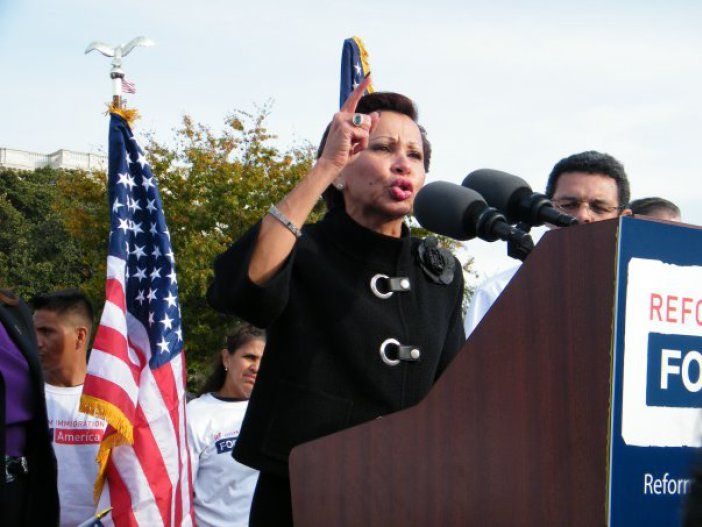Map Shows Voter Purge Hit South Slope And Sunset Park The Hardest, Velázquez Furious


Hispanic voters, many of them in South Slope and Sunset Park, were disproportionately removed from the voting rolls prior to the presidential primary in April compared to all other ethnic groups, according to a report by WNYC, and our local congresswoman is not pleased.
Using Freedom of Information Law (FOIL), WNYC obtained a list of the 125,000 voters who were removed from Board of Elections (BOE) rolls, mapping the “Hispanic sounding” names by election district and found that most of them lived in Hispanic-majority election districts like ours.
A total of 27,586 of the purged voters turned out to be in Nydia Velázquez’s 7th Congressional District, representing about 11 percent of the 253,107 registered voters there as of November 2014, which is the highest percentage among the six congressional districts that include Brooklyn neighborhoods.
“How could they purge 120,000 and no one knew that this was happening?” an outraged Velázquez told WNYC. “It’s just, by looking at that map I could say, ‘Hey, I’ve been targeted or my district has been targeted,’ just by looking at it. By looking at the numbers. We’ll see. But it’s not going to end here.”
Velázquez is a 12-term incumbent facing two primary challengers at the end of this month, businessman Yungman Lee and lawyer Jeff Kurzon.
This report comes after Executive Director of the city BOE Michael Ryan admitted, under oath, at a City Council hearing last month that “a broad cross section of voters [was] removed from the voter rolls.”
Velázquez did not mince words when she addressed the findings to WNYC this week:
“That’s [my] congressional district, almost exclusively,” Velazquez said when WNYC shared the map during an interview at her district office in Williamsburg last week. “It’s Sunset Park, both the Latino and the Asian communities. Then East New York, going into Cypress Hill.”
Velázquez’s district saw a larger purge than other congressional districts in Brooklyn, both by raw percentage and, more starkly, when weighted by the district’s proportion of total Brooklyn voters. 3
As Velazquez studied the map, her reaction shifted from shock to outrage.
“I do not want to think that it was deliberate, you know, because that would be voter suppression, and at a time when the Voting Rights Act is under attack in Washington, to have this type of action in a city and state like New York, a Democratic city, it’s just beyond any comprehension,” she said.
According to WNYC’s report, the numbers are startling:
- 13.9 percent of voters in Hispanic-majority election districts were purged compared to 8.7 percent in all other districts.
- Voters in Hispanic-majority election districts were purged at a rate 60 percent greater that everyone else.
- 15.2 percent of people with a typically Hispanic last name were purged from the Brooklyn roll, compared to 9.5 percent of all other people.
- Voters with Hispanic last names were purged at a rate 60 percent greater than all other people — about the same rate geographically.
The disparity is particularly stark in this map, which can be viewed in more detail on WNYC:

Ryan has placed blame on the Brooklyn office of the BOE. Due to a report by the city Department of Investigation in 2013 that said the office failed to remove ineligible voters — deceased or felons — from the roll, the office took it upon themselves to clean it up, according to Ryan.
According to Ryan, no voter should have been removed before receiving the status of “inactive,” which can only happen if the post office returns the notice, and the voter doesn’t partake in two subsequent federal elections. The Brooklyn office skipped this voter inactive voter step in the 2015 purge, according to Ryan.
“Although there was an otherwise political narrative out there and that fire was already stoked, by the action in Brooklyn, we added gasoline to that fire and we contributed to the lack of confidence on our own,” said Ryan. “That is regrettable. It will not happen again on my watch, and quite frankly, I understand why people are concerned.”
In light of these new findings, Velázquez says she is not satisfied with this explanation since her district appears to have been “targeted,” and she plans to ask the Department of Justice to look into the mishap.
“I am not satisfied with an explanation or an acknowledgement on the part of the executive director that this was a mistake. This is serious business. This is about democracy and about the voting rights of individuals to participate,” she told WNYC.
The staff at this office allegedly sent notices to people who hadn’t voted since 2008, informing them that their registration would be purged if they didn’t contact the board in time. Those who didn’t contact the board were purged on two dates: June 18 and July 5 in 2015.
Two top clerks at the Brooklyn BOE office have been suspended without pay, including Betty Anne Canizio, who addressed the allegations to Bensonhurst Bean. The purged voters have since been restored to the rolls after they were located on a disk at the BOE’s Brooklyn Office.
Correction [June 23, 2016 at 11:40]: We mistakenly characterized Velásquez as a 12-year incumbent. She has represented the district for 12 terms.



